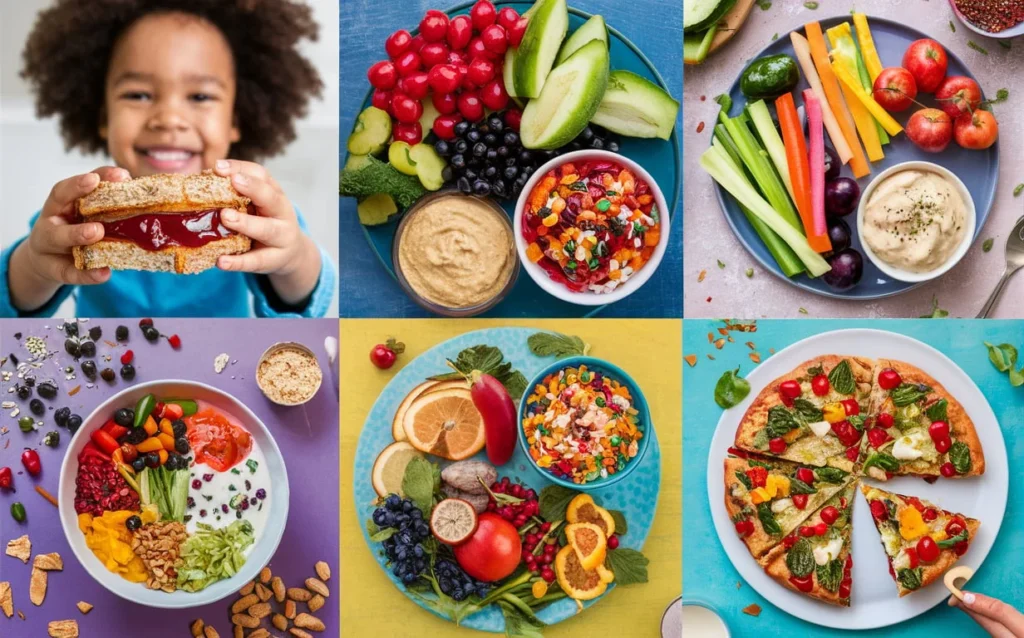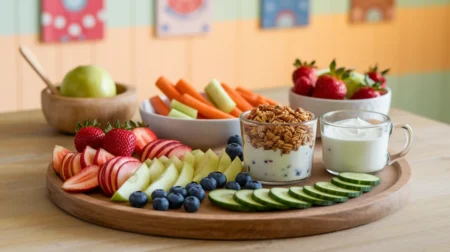Nutritious and Easy Food for 5-Year-Olds: Ideas and Tips
Key Takeaways
- Balanced meals and snacks ensure proper growth and development for 5-year-olds.
- Creative presentation and child-friendly options encourage healthy eating habits.
- Tailoring meals to nutritional needs while considering food preferences and sensitivities is key.
Nutritional Needs of 5-Year-Olds
A 5-year-old’s dietary requirements are critical for their physical and mental growth. At this age, kids need a balanced combination of carbohydrates, proteins, healthy fats, vitamins, and minerals to fuel their busy days of learning and play.
Key Nutrients to Focus On:
- Protein: Supports muscle development. Good sources include lean meat, dairy, beans, and eggs.
- Calcium and Vitamin D: Essential for bone development; found in milk, yogurt, cheese, and fortified alternatives.
- Iron: Prevents anemia; sources include lean meat, beans, lentils, and fortified cereals.
- Fiber: Aids digestion and prevents constipation. Whole grains, fruits, and vegetables are great sources.
Daily Calorie Intake Guide
On average, a 5-year-old needs around 1,200–1,600 calories per day, depending on their activity level.
Food Ideas for 5-Year-Olds
1. Breakfast Options
Oatmeal with Fruit
A warm bowl of oatmeal topped with sliced bananas, berries, or a dollop of nut butter provides fiber and energy to start the day.
Scrambled Eggs with Veggies
Add finely chopped spinach, bell peppers, or tomatoes to scrambled eggs for a nutritious and colorful start.
Yogurt Parfait
Layer Greek yogurt with granola and fresh fruit for a fun and nutritious breakfast.
2. Lunch Ideas
Whole-Grain Sandwiches
- Protein Options: Turkey, chicken, or hummus.
- Add-Ons: Cheese, lettuce, tomato slices, or cucumber for crunch.
- Tip: Use cookie cutters to make sandwiches into fun shapes to make them more appealing.
Mini Pita Pockets
Fill whole-grain pita pockets with shredded chicken, cheese, and veggies.
Cheese and Veggie Wraps
Spread cream cheese on a whole-wheat tortilla, add shredded carrots, lettuce, and thinly sliced turkey.
3. Snack Time Favorites
Fruit and Cheese Kabobs
Alternate grape tomatoes, cheese cubes, and grapes on skewers.
Homemade Trail Mix
Combine nuts, dried fruits, and whole-grain cereal for a nutritious snack (avoid nuts if allergies are a concern).
Veggie Sticks with Hummus
Offer carrots, celery, and bell pepper strips with hummus for dipping.
4. Dinner Options
Baked Chicken Nuggets
Instead of deep-fried options, coat chicken pieces with breadcrumbs and bake for a healthier twist.
Spaghetti with Hidden Veggie Sauce
Puree carrots, spinach, or zucchini into the pasta sauce for an extra dose of veggies.
Mini Meatloaves
Shape ground beef or turkey with oats, grated carrots, and onions into individual portions and bake.
5. Kid-Friendly Foods for Picky Eaters
Smoothies
Blend milk or a dairy alternative with spinach, banana, and a small amount of peanut butter. The taste is masked, making it a great way to sneak in greens.
DIY Tacos
Offer tortillas with a variety of fillings (beans, shredded cheese, avocado) and let kids build their own.
Sweet Potato Fries
Baked with a sprinkle of cinnamon or a dash of sea salt, sweet potato fries are nutritious and loved by many kids.
Soft and Easy-to-Chew Foods for Younger Kids
For 4-year-olds or younger 5-year-olds with developing chewing skills, consider these options:
- Soft-Cooked Veggies: Steam carrots, broccoli, or peas until tender.
- Mashed Potatoes or Sweet Potatoes: Easy to chew and digest.
- Banana Slices and Applesauce: Gentle on small tummies.
How to Encourage Healthy Eating Habits
1. Be a Role Model
Children often imitate what they see. Eating balanced meals yourself encourages them to follow suit.
2. Make Mealtime Fun
Use colorful plates, playful arrangements, and interactive food ideas to make meals more enjoyable.
3. Involve Kids in Cooking
When children help prepare meals, they’re more likely to try new foods. Simple tasks like washing vegetables or stirring ingredients can spark interest.
4. Offer Variety and Choices
Provide a mix of foods in different colors, textures, and flavors. Offer two healthy options so kids feel empowered to choose.
Conclusion
Feeding 5-year-olds can be a rewarding experience with the right mix of nutrition, fun, and creativity. Prioritize balanced meals, encourage trying new foods, and make eating an engaging experience. This helps build positive habits that last a lifetime.
FAQ
1. What are good sources of protein for young children?
Lean meats, eggs, beans, dairy products, and nut butters (if no allergies) are great options for children’s protein needs.
2. How do I handle picky eaters?
Offer new foods alongside familiar ones and let kids participate in meal preparation to boost their interest.
3. Are snacks necessary for a 5-year-old?
Yes, healthy snacks provide needed energy between meals. Opt for nutritious options like fruits, veggies, nuts, or whole grains.
4. What to feed kids with food allergies?
Always read labels and consider allergen-free alternatives (e.g., nut-free spreads) to ensure a balanced diet without the allergen.











